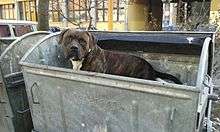Street dog
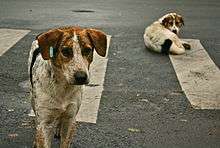

Street dogs, known in scientific literature as free-ranging urban dogs[1] or urban free-ranging dogs,[2] are unconfined dogs that live in cities. They live virtually wherever cities exist and the local human population allows, especially in the developing world and the former second world. Street dogs may be stray dogs, pets which have strayed from or are allowed freedom by their owners, or may be feral animals that have never been owned.[3] Street dogs may be stray purebreds, true mixed-breed dogs, or unbred landraces such as the Indian pariah dog. Street dog overpopulation can cause problems for the societies in which they live, so campaigns to spay and neuter them are sometimes implemented. They tend to differ from rural free-ranging dogs in their skill sets, socialization, and ecological effects.
Origin

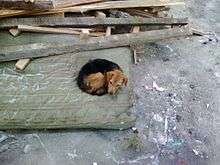
.jpg)
In much of Africa and Eurasia, most free-roaming dogs are not true mixed-breed dogs, a literal mix of one or more purebred dogs. Instead, they are descended from the same original landrace of dogs from which purebred dogs were originally created and which have existed since humans started living in settlements. They have always been scavengers living on human cast-offs and handouts. In addition to scavenging, individual street dogs are widely kept as uncontained pets by urban slum households.
Problems caused by street dogs

Disease
Outbreaks of rabies are often traced to unvaccinated street dogs, one of the most common carriers of the painful and deadly disease.
Bites
To survive, street dogs need to avoid conflict with humans. However, dog bites can occur when dogs are trying to mate or fighting among themselves, and pedestrians and other humans in the vicinity may be bitten by fighting dogs. In addition, females with pups are often protective and may bite people who approach their litter.
Quality of life
Barking and howling and dog fights which invariably take place over mating among dogs can be very disturbing to people, and the smell of dog urine which is an unsavory product of territory marking can become quite pungent, especially among unspayed or neutered dogs, not to mention the presence of feces.
Skills and adaptations
Dogs are known to be highly adaptive and intelligent species. To survive in modern cities, street dogs must be able to navigate traffic.
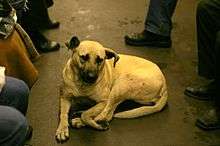
Some of the stray dogs in Bucharest are seen crossing the large streets at pedestrian crosswalks. The dogs have probably noticed that when humans cross streets at such markings, cars tend to stop.[4] The dogs have accustomed themselves to the flow of pedestrian and automobile traffic; they sit patiently with the people at the curb when they are stopped for a red light, and then cross with them as if a daily routine.[5]
In the metropolises and cities of Russia and several other countries; street dogs have been observed to "learn" to 'use' metro's and even other bus services.[6] [7]
Free-ranging urban dogs by country
South Asia

Afghanistan
Nowzad is an organisation in Afghanistan that works to rescue stray dogs in that country.[8] A group of stray dogs became famous in Afghanistan after confronting a suicide bomber, preventing fifty American soldiers from being killed.[9] However, one of the surviving dogs, Target, was mistakenly euthanized when she was brought to the United States.[10]
India
As a result of the virtual extermination by the veterinary drug diclofenac of the vultures which formerly ate animal carcasses and well as dead humans, urban India has two features which create and sustain street dog populations: large amounts of exposed animal carcasses, which provide an abundant source of food, and a huge population of slum and street-dwellers whose way of life includes keeping the dogs as free-roaming pets.[11] For example, Mumbai has over 12 million human residents, of whom over half are slum-dwellers. At least five hundred tons of garbage remain uncollected daily. Therefore, conditions are perfect for supporting a particularly large population of stray dogs. India has the highest number of human rabies deaths in the world (estimated at 20,000 per annum).[12]
In 2001, a law was passed in India that made the killing of stray dogs illegal, and residents often feed the animals as well.[13][14] In August 2014, the Delhi Police recruited many of the city's stray dogs as police dogs, after training them.[15]
Pakistan
In Pakistan, several dog breeds exist including the Gaddi Kutta, Indian pariah dog, Bully Kutta, among others.[16] In the city of Lahore, the Public Health Department launched a campaign to kill 5,000 stray dogs.[17] In 2009, 27,576 dogs were killed within the city of Lahore; in 2005, this number was 34,942.[18] In 2012, after 900 dogs were killed in the city of Multan, the Animal Safety Organisation in Pakistan sent a letter to Chief Minister (CM) "Shahbaz Sharif recommending that stray dogs be vaccinated rather than killed."[19]
Europe
Italy
Around 80% of abandoned dogs die early due to lack of survival skills.[20]
Romania

In Romania, free-ranging urban dogs (called in Romanian câini maidanezi, literally "wasteland dogs", câini comunitari "community dogs", etc.) have been a huge problem in recent decades, especially in larger cities, with many people being bitten by dogs. The problem originates primarily in the systematization programme that took place in Communist Romania in the 1970s and 1980s under Nicolae Ceaușescu, who enacted a mass programme of demolition and reconstruction of existing villages, towns, and cities, in whole or in part, in order to build standardized blocks of flats (blocuri). The dogs from the yards of the demolished houses were abandoned on the streets, and reproduced, multiplying their numbers throughout the years. Estimations for Bucharest vary widely, but the number of stray dogs has been reduced drastically in 2014,[21] after the death of 4-years old child in 2013 who was attacked by a dog. The Bucharest City Hall stated that over 51,200 stray dogs were captured from October 2013 to January 2015, with more than half being euthanized, about 23,000 being adopted, and 2,000 still residing in the municipality's shelters.[22]
Russia
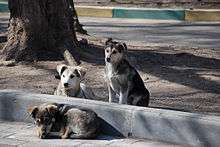
In Russia, stray dogs have been caught by doghunters' vans and destroyed since ca. 1900. Their sad lot was dramatised by Anton Chekhov in the famous short story Kashtanka, by Mikhail Bulgakov in the novella Heart of a Dog, and by Gavriil Troyepolsky in the novel White Bim Black Ear.
Serbia
Free-ranging dogs are serious problem of the Serbian cities and rural areas, where they are attacked by people, including children.[23] The total number of free-ranging dogs in Serbia is estimated at several tens of thousands,[24] of which the largest groups could be found in Belgrade (more than 17,000), Novi Sad (about 10,000), Niš (between 7,000 and 10,000), Subotica (about 8,000) and Kragujevac (about 5,000).[25]
North America
Puerto Rico
- Sato, street dogs of Puerto Rico
South-East Asia
Philippines
Locally known as Askals, street dogs in the Philippines, while sometimes exhibiting mixing with breed dogs from elsewhere, are generally native unbred mongrel dogs.
Thailand
In culture
Viață de câine (A dog's life) (1998), a Romanian documentary movie by Alexandru Solomon.
Sag-e welgard (The Stray Dog) (1942), a fiction novel by Sadegh Hedayat.
See also
References
- ↑ Daniels, T.J. (July 1983). "The social organization of free-rangingurbandogs. I. Non-estrous social behavior". Applied Animal Ethology. 10 (4): 341–363. doi:10.1016/0304-3762(83)90184-0. Retrieved 5 October 2012.
- ↑ Pal, Sunil Kumar (2001). "Population ecology of free-ranging urban dogs in West Bengal, India". Acta Theriologica. 46 (1). doi:10.1007/BF03192418. ISSN 0001-7051. Retrieved 5 October 2012.
A population of urban free-ranging dogsCanis familiaris Linnaeus, 1758 was studied in Katwa, West Bengal, India. The analysis of changes in the density of the dog population over a period of 4 years revealed a considerable stability of this population. Mean (±SD)2 seasonal population density was
- ↑ Miklósi, Adam (4 December 2008). Dog Behaviour, Evolution, and Cognition. Oxford University Press. p. 205. ISBN 9780191580130.
Some dogs lead a relatively free life despite being socialized to some extent. These dogs have or can establish a social relation with human(s) and may be fed and sheltered regularly (stray dogs, village dogs).
- ↑ "Stray Dogs Offered as Pedestrian Role Models : Discovery News". News.discovery.com. 2013-01-23. Retrieved 2013-11-16.
- ↑ "Romanian police recruit stray dogs for road safety lessons". The Raw Story. 2013-01-23. Retrieved 2013-11-16.
- ↑ "The Subway-Riding Dogs of Moscow - Oddity Central - Collecting Oddities". Oddity Central. Retrieved 15 May 2015.
- ↑ "Smartest Dogs: Moscow Stray Dogs - English Russia". englishrussia.com. Retrieved 15 May 2015.
- ↑ Itasaka, Kiko (5 October 2013). "Afghan shelter reunites dogs and cats of war with soldiers back home". NBC. Retrieved 2 October 2014.
"We don't turn any animal in need away," said Hastie, who runs the Nowzad Animal Shelter in Kabul. Nowzad is named after the small town in Helmand where the first dog was adopted in 2007. In six years, Nowzad has taken in thousands of animals of war, many of which were adopted by soldiers serving all over Afghanistan. The charity has organized the transport of over 400 dogs and cats to be reunited with former soldiers in the United States and the United Kingdom.
- ↑ Lacey, Marc (18 November 2010). "Afghan Hero Dog Is Euthanized by Mistake in U.S.". The New York Times. Retrieved 2 October 2014.
When a suicide bomber entered an American military barracks in Afghanistan in February, it was not American soldiers but Afghan stray dogs that confronted him. Target and two other dogs snarled, barked and snapped at the man, who detonated his bomb at the entrance to the facility but did not kill anyone.
- ↑ Caulfied, Philip (16 November 2010). "Target, 'war hero dog' who saved 50 soldiers in Afghanistan, mistakenly put to death in AZ shelter -". Daily News. Retrieved 3 October 2014.
A heroic dog who saved the lives of dozens of soldiers in Afghanistan and melted hearts on "Oprah" was accidentally euthanized at an Arizona animal shelter on Monday. The dog, Target, was a stray in Afghanistan who befriended soldiers and was hailed as a hero after she chased away a suicide bomber who tried to blow up a military base last February. The suicide bomber had sneaked onto the base and was headed toward a barracks that housed nearly 50 soldiers when Target and two other dogs attacked him, Target's owner, Sgt. Terry Young told Arizona's KOLD-TV.
- ↑ Markandyaa, Anil; Taylor, Tim; Longo, Alberto; Murtyd, M.N.; Murtyd, S. and Dhavalad, K.; 'Counting the cost of vulture decline—An appraisal of the human health and other benefits of vultures in India'; Ecological Economics 67 (2), 15 September 2008, pp 194–204
- ↑ Gardiner, Harris (6 August 2012). "Where Streets Are Thronged With Strays Baring Fangs". New York Times. Retrieved 24 June 2013.
- ↑ Harris, Gardiner (6 August 2012). "Where Streets Are Thronged With Strays Baring Fangs". The New York Times. Retrieved 3 October 2014.
A 2001 law forbade the killing of dogs, and the stray population has increased so much that officials across the country have expressed alarm.
- ↑ Macrae, Penelope (9 August 2012). "India stray dogs to form security squad". Yahoo!. Retrieved 3 October 2014.
A 2001 law forbids killing roaming dogs and the stray population has since soared, feeding off India's infamous mountains of street garbage as well as on kitchen scraps given to them by residents.
- ↑ Macrae, Penelope (9 August 2012). "India stray dogs to form security squad". Yahoo!. Retrieved 3 October 2014.
Stray canines roaming the Indian capital may soon find themselves attending police training school with civic authorities planning to turn the animals into security dogs, reports said Saturday. New Delhi residents have long informally adopted some strays as watchdogs for their homes and shops and fed them, but this marks the first formal plan to turn them into municipal security dogs. City authorities said they would enlist police animal trainers to work with the strays and press the canines into service as guard dogs alongside a newly formed "May I Help You?" city security force which aims to assist the public and bolster safety. "If these dogs are going to roam the NDMC (New Delhi Municipal Corp) area, they might as well work," the civic body's chairman Jalaj Shrivastava told The Hindu newspaper.
- ↑ Pathak, Arun (1995). Handicrafts in the Indus Valley Civilization. Janaki Prakashan. ISBN 8185078874.
- ↑ "City launches drive against stray dogs". The Express Tribune. The New York Times. 4 May 2011. Retrieved 2 October 2014.
The city government's Public Health Department has launched a campaign to kill nearly 5,000 dogs in the district. Officials say that the risk to public health from stray dogs increases in the summer.
- ↑ "City launches drive against stray dogs". The Express Tribune. The New York Times. 4 May 2011. Retrieved 2 October 2014.
Last year, 27,576 stray dogs were killed in Lahore. This century, the highest number of dogs killed in one year in Lahore was 34,942 in 2005.
- ↑ Malik, Sonia (21 November 2012). "850 stray dogs shot dead in a week". The Express Tribune. Retrieved 2 October 2014.
Muhammad Usman, president of the Animal Safety Organisation Pakistan, said he had written a letter to CM Shahbaz Sharif recommending that stray dogs be vaccinated rather than killed. He said he had recommended that shelter homes be built for stray animals. Usman said the government had already killed nearly 900 dogs in Multan over the last two weeks. "An injection can kill rabies germs in a dog... after that a dog attack is no longer lethal." he said.
- ↑ "NASCE MORANDO PER IL SOCIALE". pettrend.it. Retrieved 15 May 2015.
- ↑ http://adevarul.ro/news/bucuresti/bucurestiul-ramas-maidanezi-aspa-mai-jur-1500-caini-strazi-adunat-55000-1_55099f32448e03c0fdad9351/index.html
- ↑ http://www.romania-insider.com/what-happened-to-the-51000-stray-dogs-captured-in-bucharest/
- ↑ "Otrovano 5 pasa u Nišu : Hronika : Južne vesti". Juznevesti.com. Retrieved 2013-11-16.
- ↑ "Napadi pasa lutalica". e-novine.com. 2011-04-30. Retrieved 2012-08-23.
- ↑ https://web.archive.org/web/20150610223149/http://vesti.aladin.info/2013-02-20/60377326. Archived from the original on 10 June 2015. Retrieved 26 February 2013. Missing or empty
|title=(help)
Further reading
- Beck, Alan M .1973. The ecology of stray dogs: A study of free-ranging urban animals. West Lafayette, Indiana: Purdue University Press e-books.
- Ecollage. 2002. Dog Population Management & Canine Rabies Control. India's Official Dog Control Program in an international context. Pune. pp. 1–9
- Irvine, Leslie. 2003. "The Problem of Unwanted Pets: A Case Study in How Institutions "Think" about Clients' Needs" in Social Problems. Vol. 50, No. 4, pp. 550–566
- Kato Masahiko, Hideki Yamamoto, Yoshihide Inukai and Shohei Kira. 2203. "Survey of the Stray Dog Population and the Health Education Program on the Prevention of Dog Bites and Dog-Acquired Infections: A Comparative Study in Nepal and Okayama Prefecture, Japan" in Acta Med. Okayama, Vol. 57. No. 5, pp. 261–266
External links
| Wikimedia Commons has media related to Feral dogs. |
- Straydogs.ro is a reference, news, and discussion site dedicated to the issue of stray dogs, especially in Romania.
- Final solution proposed for Bucharest's stray dogs press article, May 2010
- Beastsofthebalkans.com/bulgariandogs is a specific section on stray dogs from a website on "beasts, giants & creatures of nature in Bulgaria"
- Details about the stray dog population of Sofia/Bulgaria
- wsdindia.org is a Mumbai-based organization working to eradicate rabies and control the street dog population in a humane, scientific way.
- Account of stray dogs in Moscow, January 2010
